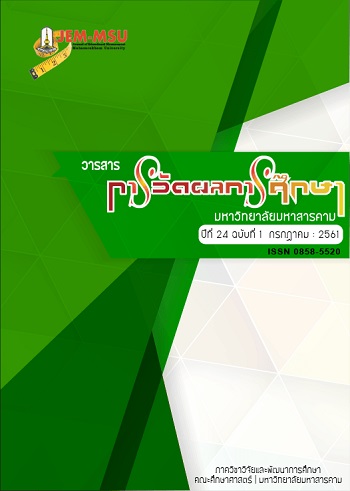The Development of Blended Learning Instruction Model Based on Elaboration Theory to Enhance Learning Transposition and Problem-Solving Ability for Student at the Certificate Level
Main Article Content
Abstract
This research is a Research and Development model which aims to 1) synthesize
blended learning model based on elaboration theory to enhance learning transposition and
problem-solving ability for Student at the Certificate Level, 2) evaluate suitability of the synthesized
model. The research method was separated into 2 phrases; 1) synthesize teaching model by
in-depth interview with 10 teaching professionals based on elaboration theory about learning
transposition and problem solving skills using purposive sampling, information were collected by
receiving ideas and suggestions to be synthesized and develop a learning model, 2) evaluate
suitability of the synthesized model with 5 highly qualified personals using purposive sampling,
assessment forms were used to find suitability of model and data were analyzed by mean and
standard deviation.
The research found that:
1) Result of synthesis and validation of blended learning model with elaboration theory
to enhance learning transposition and problem solving ability for students at vocational certificate
level. After the test, the researcher introduced revised blended learning model with theory of
conceptual elaboration to 5 higher educational technology experts to certify learning model with 3
following components (1) content preparation, (2) Learning Process, and (3) Evaluation process.
There are 3 following steps to promote learning transposition; 1) Stimulate experience, 2) create
learning transposition, 3) promote learning transposition. There are 3 steps in promotional to
problem solving; 1) to understand hypothetical problems, 2) to problem analysis and taking action,
3) to investigate and improve the solution.
2) The suitability assessment results of the synthesized model could be summarized
into 4 aspects thus, 1) developed teaching model component are suitable at highest level
( x =4.73, S.D.=0.40), 2) teaching model activities that promotes learning transposition are
suitable at highest level ( x =4.60, S.D.=0.55), 3) teaching model activities that promote
problem solving skills are suitable at highest level ( x =4.76, S.D.=0.40), 4) feasibility of
teaching model on actual implementation are suitable at highest level ( x =4.60, S.D.=0.55).
This showed the synthesized teaching model has the highest level of evaluation and can be
used as a model for development of teaching and learning tools.
Article Details
The content and information contained in the published article in the Journal of Educational Measurement Mahasarakham University represent the opinions and responsibilities of the authors directly. The editorial board of the journal is not necessarily in agreement with or responsible for any of the content.
The articles, data, content, images, etc. that have been published in the Journal of Educational Measurement Mahasarakham University are copyrighted by the journal. If any individual or organization wishes to reproduce or perform any actions involving the entirety or any part of the content, they must obtain written permission from the Journal of Educational Measurement Mahasarakham University.
References
สินสินค้า และพัสดุภัณฑ์ (ร.ส.พ.).
2. เกียรติศักดิ์ วจีศิริ. (2553). การพัฒนารูปแบบการเรียนรูแบบน าตนเองบนเว็บเพื่อเสริมสร้างความสามารถใน
การคิดวิเคราะห์และผลสัมฤทธิ์ทางการเรียนของนักเรียนระดับประถมศึกษา.วิทยานิพนธ์ปรัชญา
ดุษฎีบัณฑิต สาขาวิชาเทคโนโลยีเทคนิคศึกษา ภาควิชาครุศาสตร์เทคโนโลยี บัณฑิตวิทยาลัย
มหาวิทยาลัยเทคโนโลยีพระจอมเกล้าพระนครเหนือ.
3. ฆนัท ธาตุทอง. (2551). การออกแบบการสอนและบูรณาการ. นครปฐม: เพชรเกษมการพิมพ.
4. สัมฤทธิ์ เสนกาศ. (2553). การพัฒนารูปแบบการเรียนรูแบบผสมผสานเนื้อหาและกิจกรรมการเรียนด้านการ
เขียนโปรแกรมคอมพิวเตอร์. วิทยานิพนธ์ปรัชญาดุษฎีบัณฑิต สาขาวิชาคอมพิวเตอร์ศึกษา ภาควิชา
คอมพิวเตอร์ศึกษา บัณฑิตวิทยาลัยมหาวิทยาลัยเทคโนโลยีพระจอมเกล้าพระนครเหนือ.
5. อินทิรา รอบรู้ และกฤษมันต์ วัฒนาณรงค์ (2553). การพัฒนารูปแบบการเรียนการสอนแบบผสมผสานเพื่อ
เพิ่มประสิทธิภาพในการแสวงหาความรู้ด้วยตนเอง. วารสารวิชาการครุศาสตร์อุตสาหกรรม พระจอม
เกล้าพระนครเหนือ 1,2(2553) : 13-15.
6. Hunter, M. (1995). Teach for transfer. CA : Corwin.
7. Jackson, R.G. (1993). The effect of elaboration theory in facilitating achievement of varied
educational objectives in print/text material. [Online] Dissertation Abstracts International
: 54-05A. Abstract from : http://buu.thailis.uni.net.th/dao/detail.nsp [2015, May 8]
8. Ndon, Udeme Taylor. (2007). “The Lived Experiences of University Faculty Who Teach Using
aHybrid Instructional Model.” Dissertation Abstract International. 67


